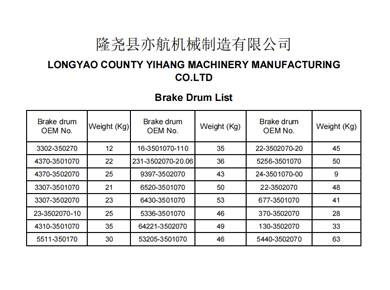Nov . 26, 2024 00:18 Back to list
parts of brake drum
Understanding the Parts of a Brake Drum
A brake drum is an essential component in a vehicle's braking system, particularly in older cars and some modern vehicles. It plays a critical role in ensuring the safety and efficiency of the braking process. To fully appreciate the function of a brake drum, it's essential to understand its various parts and their significance.
1. Brake Drum
The brake drum itself is a cylindrical piece made from cast iron or aluminum, designed to create friction with the brake shoes. When the brake pedal is pressed, the brake shoes expand and press against the inside surface of the drum, generating the friction needed to slow down or stop the vehicle. The material and design of the drum are vital; they must withstand high temperatures and repeated stress without deforming.
2. Brake Shoes
Brake shoes are curved components that sit inside the brake drum. When the brake is applied, the brake shoes are pushed outward against the drum's inner surface. The shoes are typically lined with a friction material that provides the necessary grip to stop the vehicle. Over time, the lining can wear down, necessitating replacement to maintain braking effectiveness.
3. Wheel Cylinder
The wheel cylinder is a crucial part of the hydraulic braking system. It houses pistons that, when activated by hydraulic fluid from the brake master cylinder, push the brake shoes outward against the drum. This action is what ultimately brings the vehicle to a halt. A malfunctioning wheel cylinder can lead to uneven brake force or brake failure, making it vital for safe operation.
4
. Brake Hardwareparts of brake drum

Various hardware components support the brake shoes and wheel cylinder, ensuring everything functions in harmony. This includes springs, clips, and retainers. The return springs play a significant role by pulling the brake shoes back to their original position when the brake pedal is released. Properly functioning hardware prevents dragging brakes, which can cause premature wear and reduced fuel efficiency.
5. Adjuster Mechanism
The adjuster mechanism is essential for maintaining the correct distance between the brake shoes and the drum. This mechanism compensates for wear in the brake shoe linings, ensuring the shoes remain effective throughout their lifespan. An incorrectly adjusted brake system can lead to diminished braking power and increased stopping distances, posing a risk to safety.
6. Backing Plate
The backing plate is a strong, rigid structure that serves as a mount for the brake components. It provides a surface to which the wheel cylinder and the brake shoes are affixed. The backing plate also helps to protect the drum and other parts from dirt and debris, extending their life and maintaining performance.
7. Drum Ventilation Slots
Many modern brake drums feature ventilation slots or holes. These are designed to dissipate heat more effectively during braking. Excessive heat can lead to brake fade, where the braking performance is reduced due to overheating. Ventilated drums help maintain optimal temperatures, ensuring consistent braking performance.
Conclusion
Understanding the parts of a brake drum and their functions is crucial for both vehicle owners and mechanics. Regular maintenance and awareness of these components can prevent potential braking issues and enhance safety on the road. As technology evolves, brake systems continue to innovate, yet the fundamental importance of the brake drum and its parts in ensuring vehicle safety remains unchanged. Whether you're a seasoned automotive enthusiast or a casual driver, knowledge of your braking system is an essential aspect of vehicle care.
-
Scania Brake Drums: OEM Quality for Optimal Safety & Durability
NewsAug.16,2025
-
R.V.I: Advanced Remote Visual Inspection for Precision
NewsAug.15,2025
-
Discover HYUNDA: Innovative Vehicles, Equipment & Solutions
NewsAug.14,2025
-
R.V.I: Unlock Advanced Insights & Real-time Performance
NewsAug.13,2025
-
Kamaz Brake Drum: Durable & Reliable for Heavy Duty Trucks
NewsAug.12,2025
-
Heavy Duty Iveco Brake Drum - Premium Quality & Safety
NewsAug.11,2025
